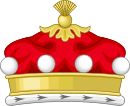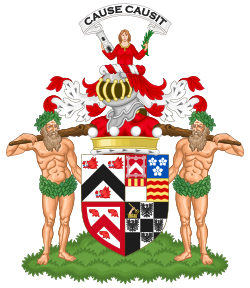Lord Elphinstone facts for kids
Quick facts for kids Lordship of Elphinstone |
|
|---|---|
|
Blazon
Quarterly: 1st grand quarter: Argent a Chevron Sable between three Boars' Heads erased Gules armed of the field and langued Azure (Elphinstone); 2nd grand quarter: quarterly, 1st, Gules a Chevron within a Double Tressure flory counterflory Argent (Fleming); 2nd, Azure three Frases Argent (Fraser); 3rd, Argent on a Chief Gules three Pallets Or (Keith); 4th, Or three Bars wavy Gules (Drummond); 3rd grand quarter: Argent a Chevron between three Otters' Heads erased Gules within a Bordure of the last (Fullerton); 4th grand quarter: Sable on a Cross Argent square pierced of the field four Eagles displayed of the first in the dexter canton an Arm embowed proper issuing out of a Naval Crown the hand holding a Trident Or (Buller)
|
|
| Creation date | 14 January 1510 |
| Peerage | Peerage of Scotland |
| First holder | Alexander Elphinstone, 1st Lord Elphinstone |
| Present holder | Alexander Mountstuart Elphinstone, 19th Lord Elphinstone, 5th Baron Elphinstone |
| Heir apparent | the Hon. Jago Alexander Elphinstone, Master of Elphinstone |
| Subsidiary titles | Baron Elphinstone |
| Seat(s) | Whitberry House |
| Motto | Cause Causit (Scots) |
The title of Lord Elphinstone is a special noble rank in Scotland. It was first created by King James IV in 1510.
Contents
History of the Lords Elphinstone
The first Lord Elphinstone was Sir Alexander Elphinstone. King James IV gave him this important title in 1510. Sadly, Sir Alexander died just three years later in a big battle called the Battle of Flodden.
His son became the second Lord Elphinstone. He also died in battle, at the Battle of Pinkie Cleugh in 1547. Later, the fourth Lord Elphinstone held a very important job: he was the Lord High Treasurer of Scotland. This meant he was in charge of the country's money.
Later Generations and New Titles
Many years later, the eleventh Lord Elphinstone became a Scottish Representative Peer. This meant he was chosen to represent Scotland's nobility in the House of Lords in the British Parliament. He served there from 1778 to 1794. His son, the twelfth Lord, was a high-ranking officer in the Army. He also served as a Scottish Representative Peer and was the Lord Lieutenant of Dunbartonshire, a royal representative in a Scottish county.
The thirteenth Lord Elphinstone had an exciting career. He was a Scottish Representative Peer and also served as a Governor in both Bombay and Madras, which were parts of India under British rule at the time. In 1859, he was given another title: Baron Elphinstone. This new title was part of the Peerage of the United Kingdom, which is different from the Scottish peerage. However, this specific Baron title ended when he died in 1860 because he had no children to pass it on to.
The main Lord Elphinstone title then went to his cousin, the fourteenth Lord. When he died a year later, the title passed to his second cousin, the fifteenth Lord. This Lord Elphinstone also served as a Scottish Representative Peer in the House of Lords. He worked for the government as a Lord-in-waiting, which is like a government helper in Parliament. In 1885, he was also made Baron Elphinstone in the Peerage of the United Kingdom. This new Baron title allowed the Lords Elphinstone to automatically have a seat in the House of Lords until 1999. After 1999, new rules meant that most hereditary peers no longer had an automatic right to sit in Parliament.
Recent Lords Elphinstone
The sixteenth Lord Elphinstone married Lady Mary Bowes-Lyon in 1910. She was the older sister of Queen Elizabeth The Queen Mother, who was the wife of King George VI and mother of Queen Elizabeth II. This means the Elphinstone family has a connection to the British Royal Family!
The seventeenth Lord Elphinstone was a Prisoner of War during World War II. He was held at Colditz Castle, a famous prisoner-of-war camp. When he passed away in 1975, his nephew became the eighteenth Lord.
As of 2022, the current Lord Elphinstone is the nineteenth Lord, Alexander Mountstuart Elphinstone. He became Lord Elphinstone in 1994 when he was just fourteen years old. He is also the Chief of Clan Elphinstone, which means he is the traditional leader of the Elphinstone family clan. He is a third cousin of the Prince of Wales.
The family's main home is Whitberry House, located near Tyninghame in East Lothian, Scotland.
Other Notable Elphinstones
The Elphinstone family has many other important members throughout history.
- James Elphinstone, 1st Lord Balmerino was a younger son of the third Lord Elphinstone.
- His younger son was James Elphinstone, 1st Lord Coupar.
- Another famous family member was George Keith Elphinstone, 1st Viscount Keith, a naval officer.
- His daughter, Margaret Keith, 2nd Baroness Keith, inherited the Lordship of Nairne title.
Lords Elphinstone (since 1510)
This is a list of the people who have held the title of Lord Elphinstone since it was created.
- Alexander Elphinstone, 1st Lord Elphinstone (died 1513)
- Alexander Elphinstone, 2nd Lord Elphinstone (1510–1547)
- Robert Elphinstone, 3rd Lord Elphinstone (1530–1602)
- Alexander Elphinstone, 4th Lord Elphinstone (1552–1638)
- Alexander Elphinstone, 5th Lord Elphinstone (1577–1648)
- Alexander Elphinstone, 6th Lord Elphinstone (1620 - 1654)
- Alexander Elphinstone, 7th Lord Elphinstone (1647–1669)
- John Elphinstone, 8th Lord Elphinstone (1649–1718)
- Charles Elphinstone, 9th Lord Elphinstone (1676–1757)
- Charles Elphinstone, 10th Lord Elphinstone (1711–1781)
- John Elphinstone, 11th Lord Elphinstone (1737–1794)
- John Elphinstone, 12th Lord Elphinstone (1764–1813)
- John Elphinstone, 13th Lord Elphinstone (1807–1860)
- John Elphinstone, 14th Lord Elphinstone (1819–1861)
- William Buller Fullerton Elphinstone, 15th Lord Elphinstone, 1st Baron Elphinstone (1828–1893)
- Sidney Herbert Elphinstone, 16th Lord Elphinstone, 2nd Baron Elphinstone (1869–1955)
- John Alexander Elphinstone, 17th Lord Elphinstone, 3rd Baron Elphinstone (1914–1975)
- James Alexander Elphinstone, 18th Lord Elphinstone, 4th Baron Elphinstone (1953–1994)
- Alexander Mountstuart Elphinstone, 19th Lord Elphinstone, 5th Baron Elphinstone (born 1980)
Family Coat of Arms
|
The Elphinstone family has a special design called a coat of arms. This design shows symbols that represent their family history and achievements.
- The crest is the part on top of the helmet. For the Elphinstones, it shows a lady holding a tower and a laurel branch.
- The escutcheon is the main shield. It's divided into four big sections, each showing symbols from different families that have joined the Elphinstones through marriage. For example, it includes symbols for Elphinstone, Fleming, Fraser, Keith, Drummond, Fullerton, and Buller families.
- The supporters are figures on either side of the shield. The Elphinstone coat of arms has two "Wild Men" holding clubs.
- The motto is a short phrase. The Elphinstone motto is "Cause Causit," which means "Cause caused it."
See also
- Clan Elphinstone
- Elphinstone baronets
- Lord Balmerinoch
- Lord Coupar
- Lord Nairne
- William Elphinstone, Lord Elphinstone, a senator of the College of Justice, 1637





